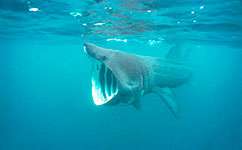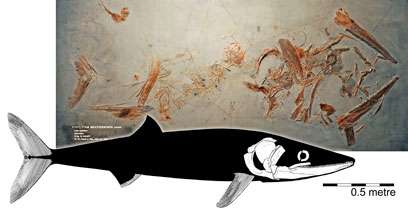Animals from very different groups that developed independently into plankton-eating giants took similar evolutionary steps along the way, new research shows.
The study suggests ancient relations of today's bony fishes took a path towards this feeding method similar to the one that whales and sharks would develop along millions of years later.
This suggests that gigantic suspension feeders, which live by filtering innumerable tiny plankton from the water, fill an important ecological role that animals of one kind or another can generally be expected to evolve to exploit. It also means these different groups of animals may undergo a similar series of changes as they evolve towards the same destination.
These include changes in jaw shape, gradual loss of teeth and eventually a shift in diet towards plankton and away from bigger prey. Animals could conceivably evolve into plankton-scoffing behemoths along a different path, but this research suggests they haven't done so.
Modern suspension feeders include whale sharks, basking sharks and manta rays, as well as baleen whales and smaller creatures like paddlefish. But the new findings come from studying fossils of Ohmdenia, a long-extinct animal whose closest living relatives are familiar fishes like cod, goldfish and plaice.
'This really improves our understanding of how giant suspension feeding evolved; until now it's been based on just one group of animals – the whales,' says Dr Matt Friedman, a palaeontologist at the University of Oxford and author of the paper, published in Proceedings of the Royal Society B. 'It was amazing to find the evidence has been on display in a public museum for half a century!'
Until now, whales were the only group whose evolution into giant suspension feeders was reasonably well understood, because of an abundant fossil record. But today's whales are young in evolutionary terms, and scientists weren't certain whether or not their evolutionary path was typical. How sharks developed into this niche is uncertain because their cartilaginous skeletons don't fossilise well, and they leave behind a fossil record consisting mostly of teeth.
The only known fossil specimen of Ohmdenia, with a reconstruction of how the fish would have looked.
Friedman made the breakthrough by examining the only known specimen of Ohmdenia, an ancient fish that has until now been miscategorised since the 1950s.
Ohmdenia lived around 180 million years ago, early on in the Jurassic period. Friedman has shown it was a member of the now-extinct pachycormiforms, an evolutionary lineage that inhabited the Mesozoic oceans for tens of millions of years but whose last members went extinct at around the same time as the dinosaurs, perhaps killed off by the same disaster.
Most pachycormids appear to have been open-ocean predators similar to the tuna or swordfish, but Ohmdenia seems to have been on its way to evolving into a giant suspension feeder. The sole known Ohmdenia fossil, kept in a museum in Tübingen in Germany, seems to come from an individual about 2.5 metres long, but Friedman says that later suspension-feeding pachycormids might have reached lengths of 8-10m.
'We knew that pachycormiforms developed into giant suspension-feeders later in the Jurassic, but we didn't know this was already happening so early in the period. It shows that they were a real evolutionary success story, exploiting this strategy for over 100 million years' says Friedman.
Ohmdenia's jaws had already become elongated, reducing their power to bite into prey, and its teeth were getting shorter and blunter, more suited to grasping than cutting or puncturing.
It probably lived on soft-bodied creatures like belemites (squid-like animals whose fossilised remains, looking like slim bullets, are still common.) There's even a fossil belemite amid Ohmdenia's remains, which might have been in its stomach when it died, although we can't say for sure.
The closest living relatives of the pachycormiforms are the teleosts - an incredibly diverse and numerous group including most fish, excepting a few creatures like sharks, sturgeons and lampreys. In fact, around half of all known vertebrates – animals with a backbone – are teleosts.
Friedman saw an illustration of the sole specimen in an old monograph, and realised it looked far more like a pachycormiform than a birgeriid, the extinct group to which it had wrongly been assigned. In particular, it had key features of pachycormiforms: a highly symmetrical tail and scythe-like forefins.
He travelled to Tübingen and spent a couple of days poised on a rickety platform examining the fine details of the specimen, which hangs on a wall several metres above the ground.
It's still uncertain exactly how an animal goes from open-ocean predation to eating plankton. Friedman says that in whales, it looks like jaws lengthened and teeth became blunter and less pronounced in close extinct relatives of baleen whales.
There's some evidence that they spent a long time on this diet while also developing the baleen plates that let them filter plankton from the water. Some fossil whales that still ate bigger prey show evidence of the network of blood vessels needed to nourish the baleen, which is a living tissue, made of the same material (keratin) as human fingernails and hair.
Since investigating Ohmdenia, Friedman has been looking at the evolution of paddlefish, which are relatively small freshwater plankton-eaters. He's now interested in examining the sharks and their kin, to try to understand how the giant suspension-feeding lifestyle arose independently in basking sharks, whale sharks and manta rays, perhaps confirming that they followed the same basic sequence as pachycormiforms and whales.
More information: Parallel evolutionary trajectories underlie the origin of giant suspension-feeding whales and bony fishes, Matt Friedman, Proc. R. Soc. B. DOI: 10.1098/rspb.2011.1381
Provided by PlanetEarth Online
This story is republished courtesy of Planet Earth online, a free, companion website to the award-winning magazine Planet Earth published and funded by the Natural Environment Research Council (NERC).






















